Eddie Howe’s work was nothing short of a master class.
The Englishman took over a faltering Newcastle side in November of 2021, with the club sitting 20th in the EPL table with six points from 12 matches. House management and significant investment in the January transfer window saw the club climb to 11th by season’s end.
Going into last season, Newcastle were a team on the rise. They were one to watch.
Even with the extra attention and investment, surely only some expected them to secure Champions League play as early as they did. Surpassing the likes of Liverpool, Tottenham and Chelsea, Newcastle enters the 2023/24 campaign as one of the EPL’s four Champions League representatives for the first time since 2003.
This tactical analysis pulls from last year’s matches to preview Howe’s tactics ahead of the upcoming campaign. With Newcastle clinching Champions League play for the first time in two decades, this scout report will factor in the additional competition, assessing how it will impact Newcastle on both fronts.
After averaging just 1.16 goals per game in 2021/22, Newcastle picked up their attacking production last season, tallying 68 goals (1.79 per game) on 72.76 xG. Looking at their shot map, they pummelled the opposition’s goal zone with scoring opportunities.
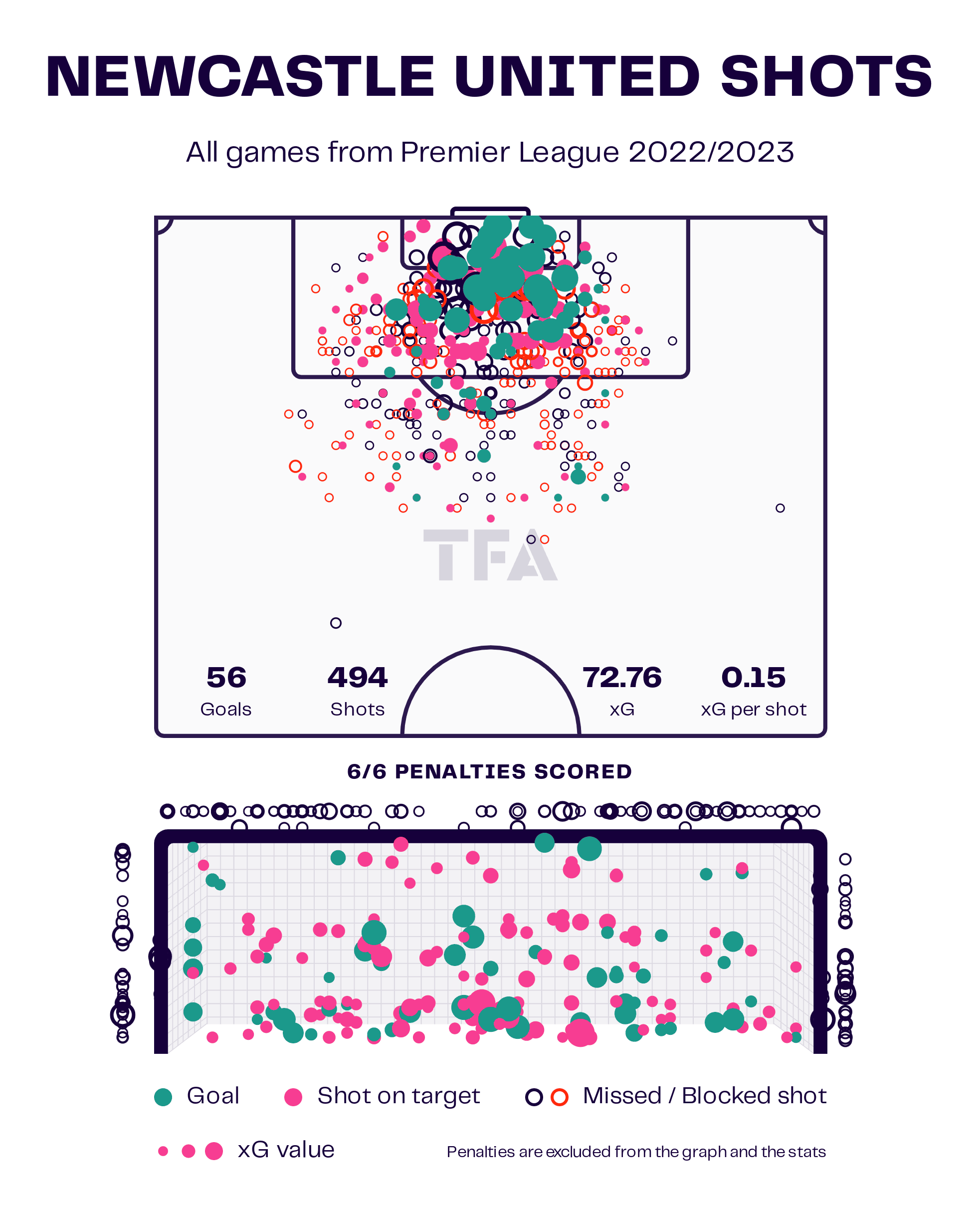
In 2021/22, Newcastle were one of the worst defensive sides in Europe. Conceding 62 goals in 38 matches, defensive tactics were a clear focus for Howe. In one season, he reduced the club’s goals against mark to just 33, tying Manchester City for the best defensive record in the league.
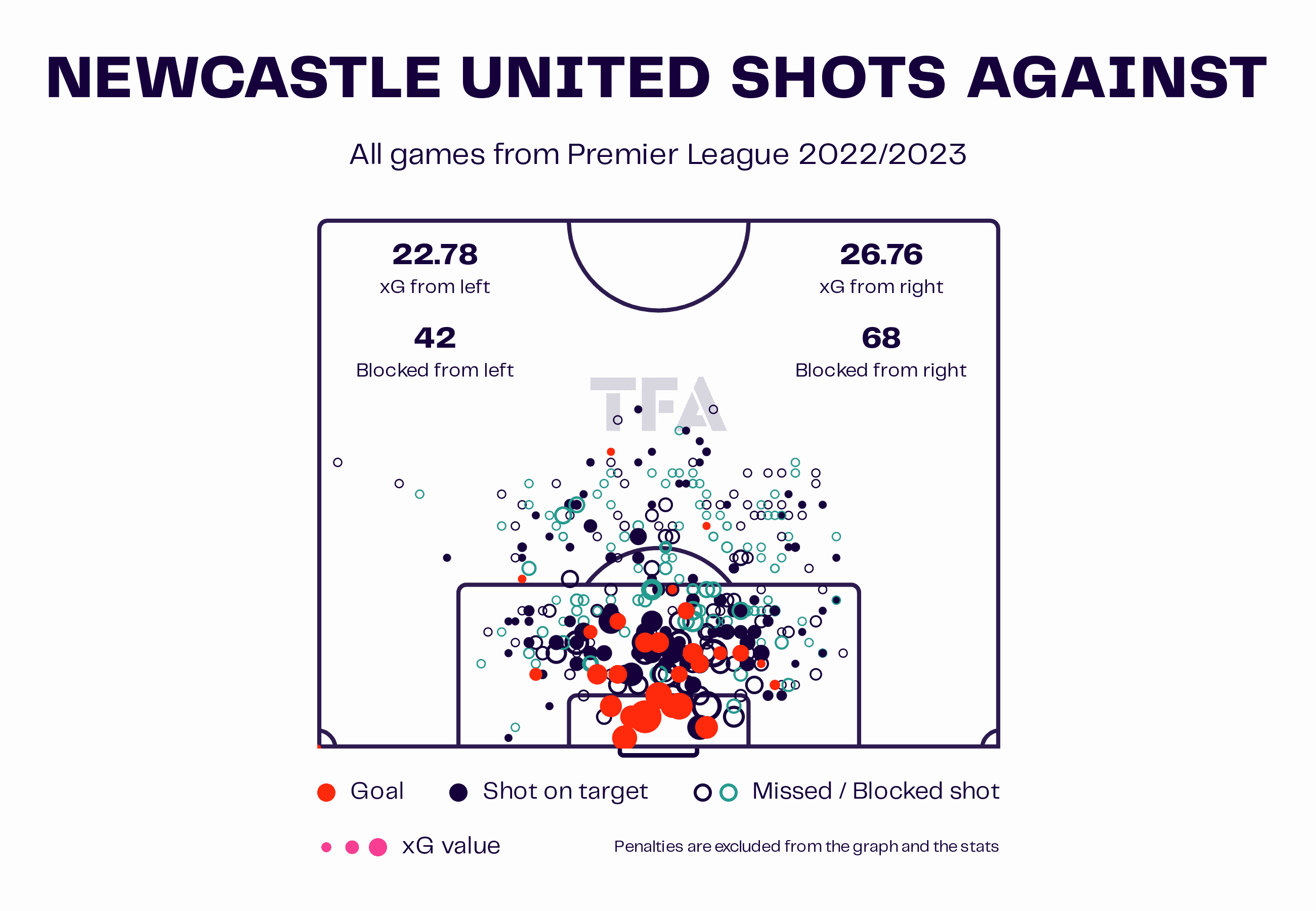
Sven Botman played a significant role, recording 3,128 minutes at centreback, as did his positional partner Dan Burn. Meanwhile, Bruno Guimarães offered protection in front of them. They also had a solid season from Nick Pope in goal, who made the move from Burnley.
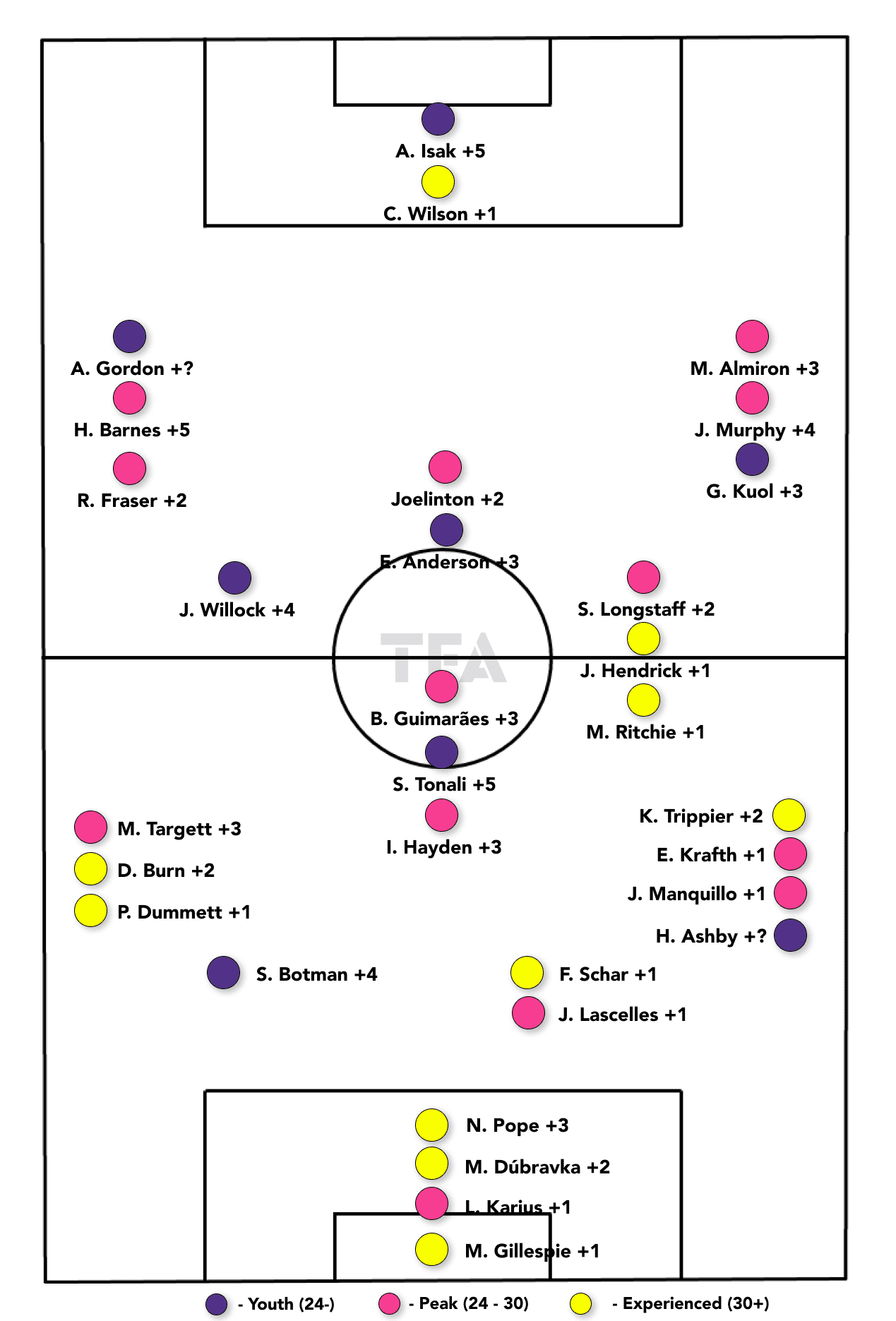
The exciting addition to the squad is the former AC Milan man Sandro Tonali. The 23-year-old defensive midfielder arrives at St. James’ Park after a sensational start to his career in Milan.
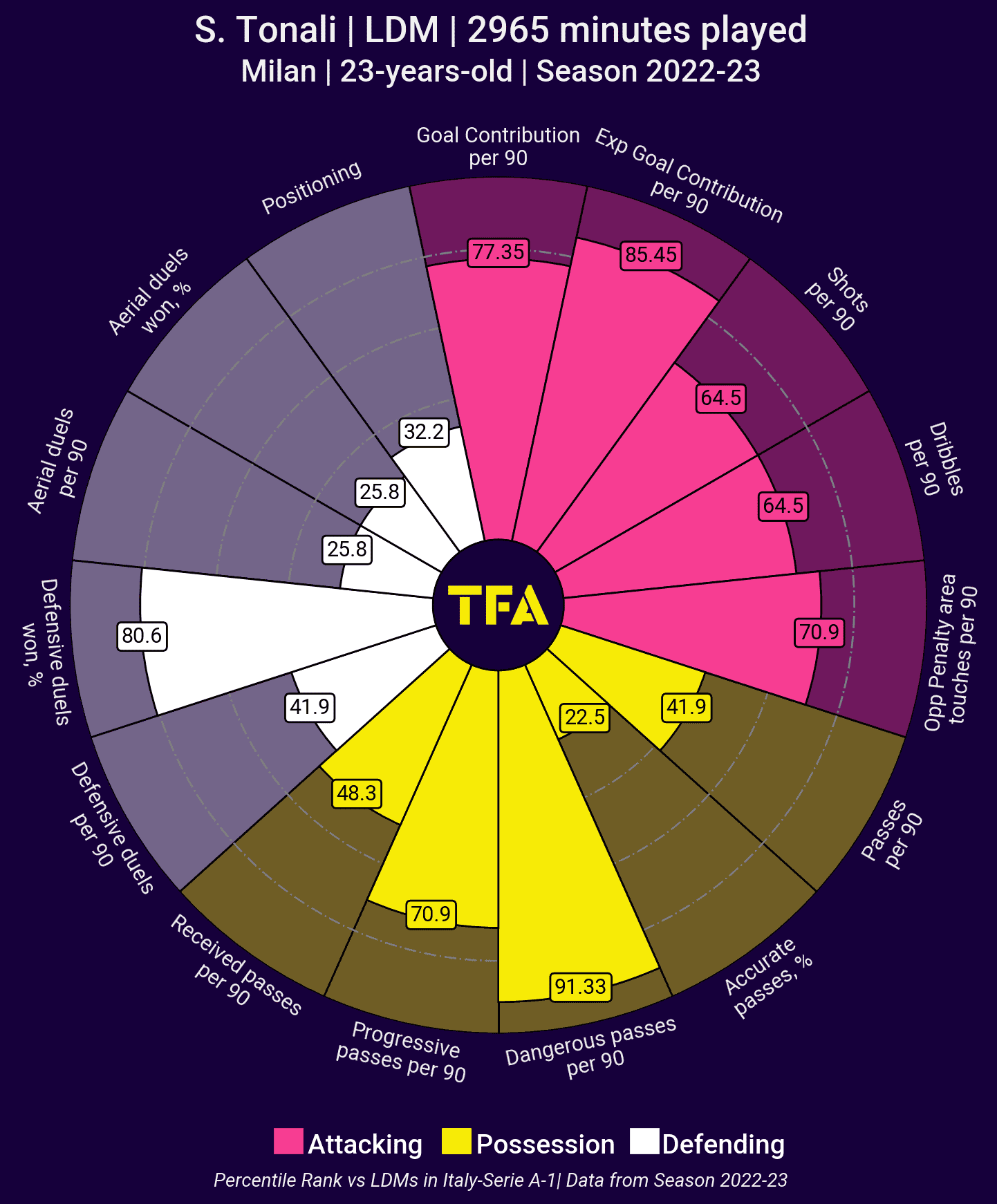
He’s a deep-lying midfielder with a knack for scoring goals. Though he plays a deeper role, he’s an exceptional attacking player with a flare for dynamic playmaking. Whether on the dribble or with his scintillating passing, Tonali gives the Newcastle midfield another creator.
Attacking phase
Turning to the tactical breakdown, we’ll first gauge some of the trends to look for in Newcastle’s attacking tactics, followed by an analysis of their defending and transitional principles of play.
One of the more interesting approaches to Newcastle’s attacking tactics is the positional relation of the lines. It’s common to see anywhere from two to four players in the highest line to stretch the pitch and offer runs in behind. Meanwhile, the midfield is working hard underneath them to find pockets of space between the lines.
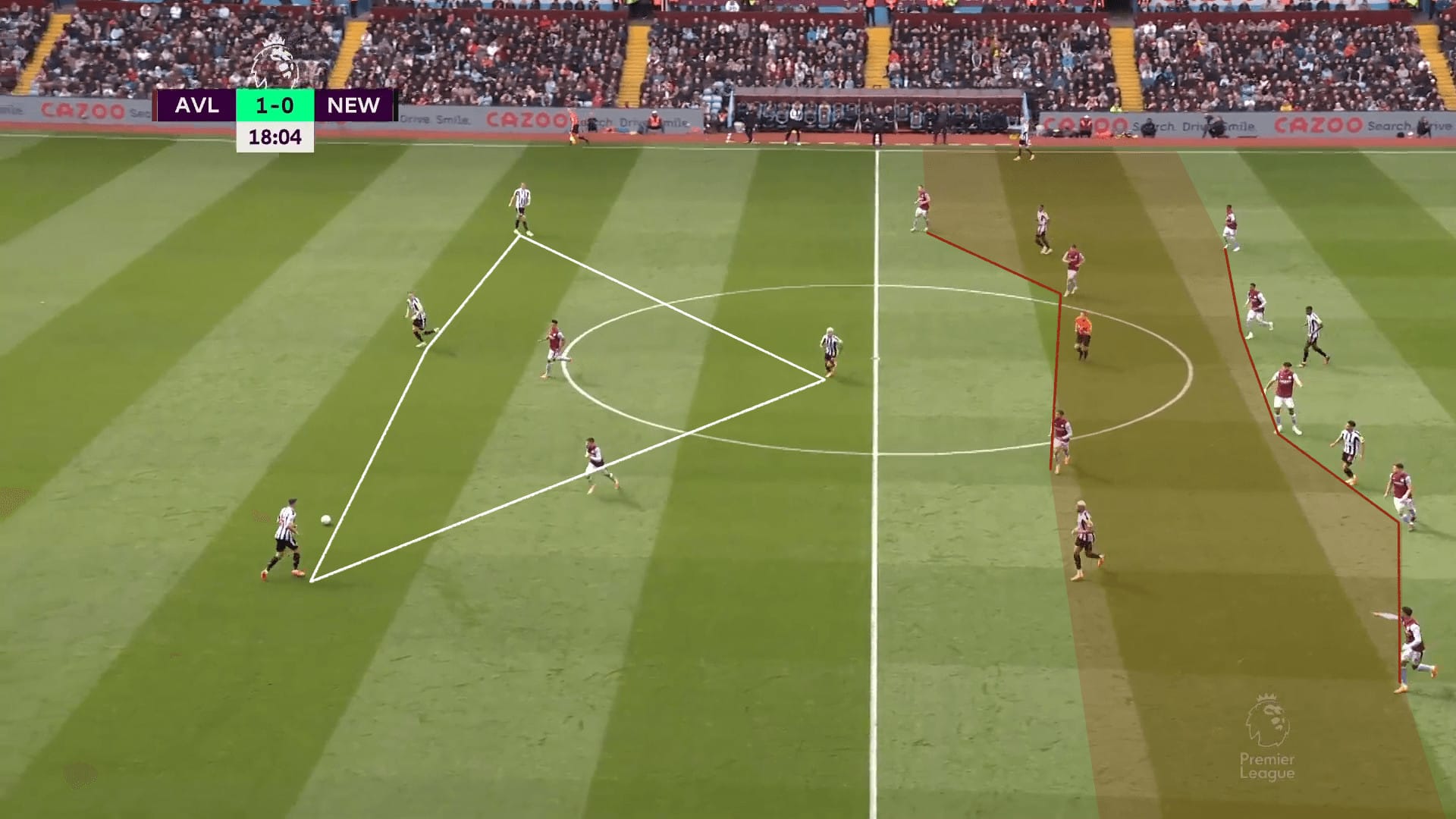
Teams that had success slowing Newcastle down, and there weren’t many, tended to defend with a mid-block and send limited numbers of the pitch to pressure Newcastle’s backline. That orientation, which typically led to defending in a 5-3-2 or 4-4-2, eliminated those spaces between the lines, which would trigger Newcastle to play negatively in an effort to draw the opposition’s lines higher up the pitch. In doing so, the objective was to create greater distances between the lines.
In this Aston Villa example, the first image shows the midfield and backlines are approximately 6m apart. Notice the positioning of the Newcastle midfield. One is low, and two are high. When that high space is unavailable, one midfielder will check to the ball to offer support and possession and drag a defender with him higher up the pitch.
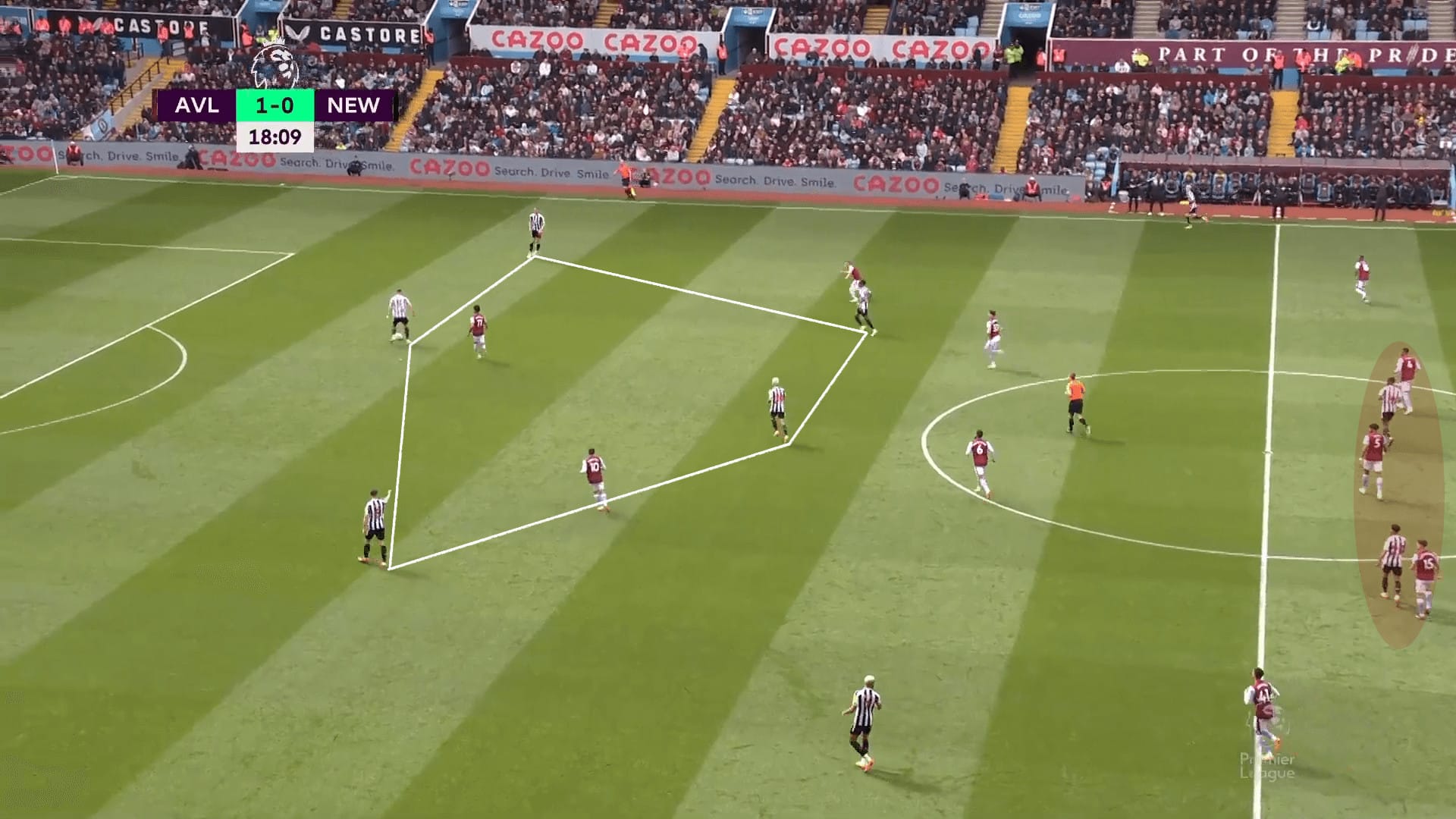
When the opponent’s lines become too compact in the mid-block, that’s when Newcastle are most dangerous. They’ll look for that ball over the top, typically finding the runs of one of their wingers. In the 6-1 drubbing of Tottenham, Joelinton timed his run to perfection to get behind the back line and round Hugo Lloris for the second goal.
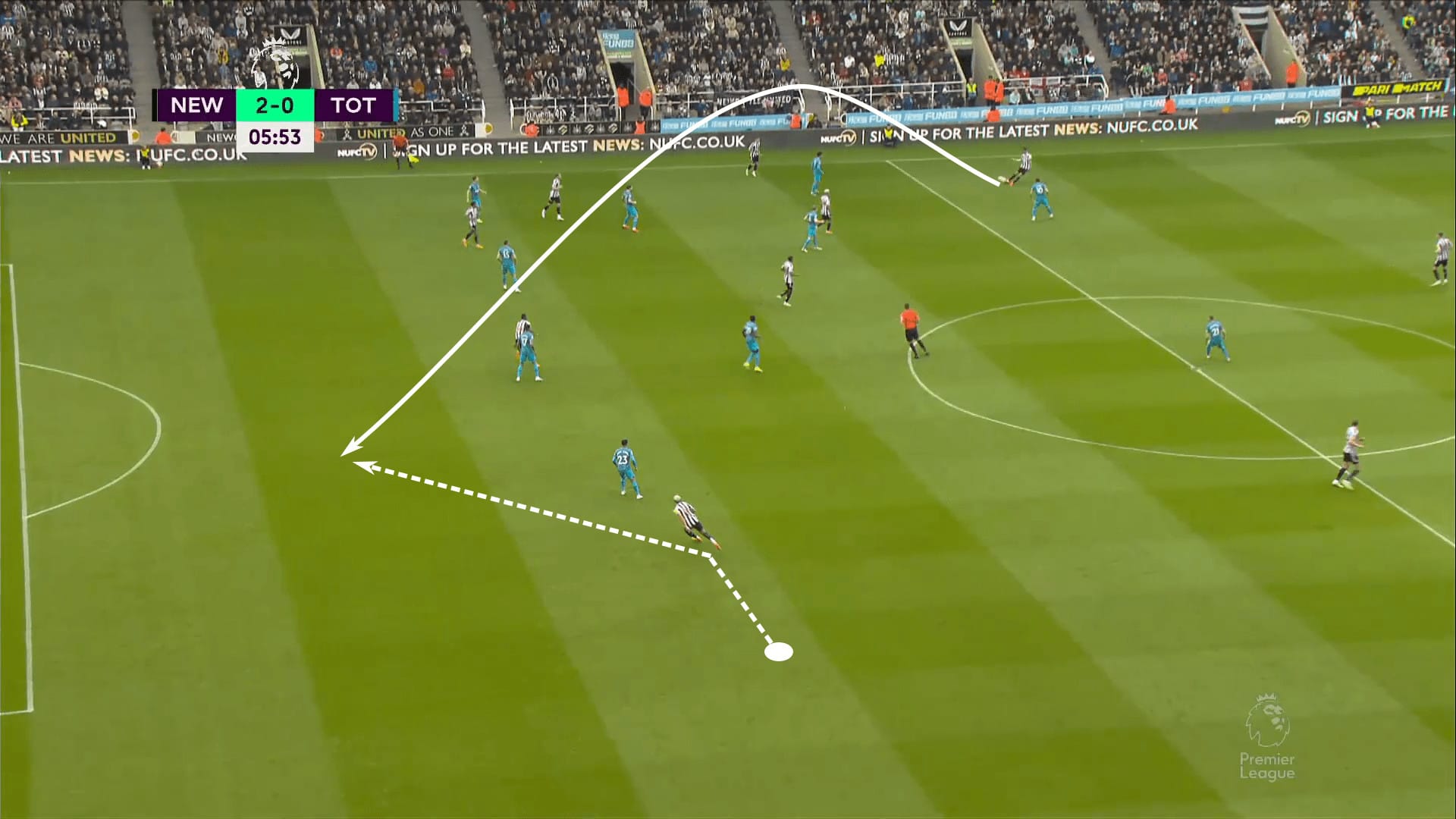
When they aren’t going for the killer pass, look for Newcastle to create a limited number of overloads in the wings, often in 1v1, 2v1 or 2v2 scenarios, before sending a delivery into the box. In our example against Brighton, the 2v2 leads to a dangerous move into the penalty box with three attackers in the high central overload. Newcastle had a fantastic setup to attack the box, but a poor delivery from Alexander Isak allowed Brighton to clear the ball.
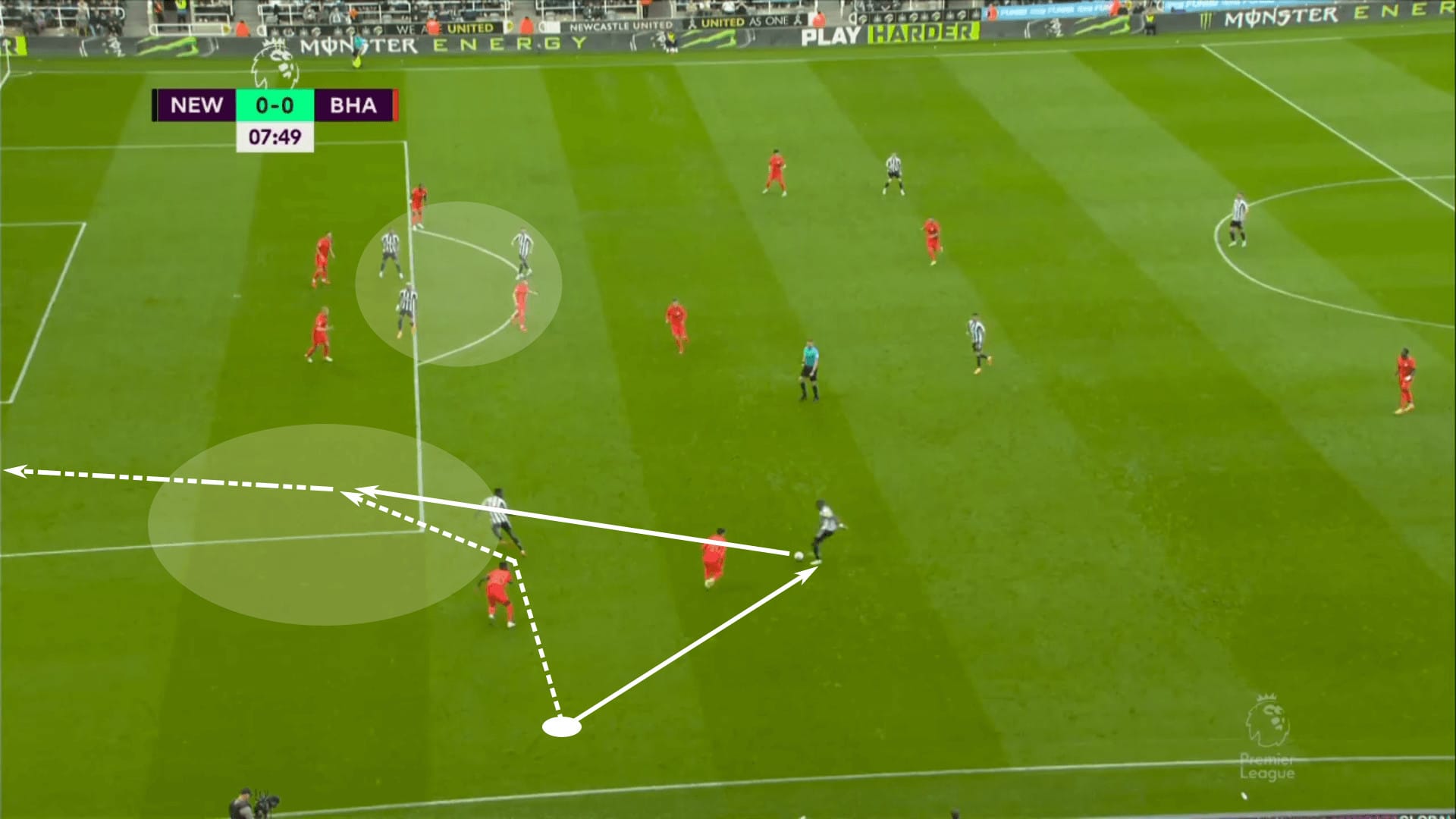
This Newcastle attack is highly effective in their preferred patterns. They’re challenging to contain and use excellent changes in tempo to catch opponents off guard. The runs of the forwards and midfielders are exceptional, while the deeper players have the ability to hurt opponents with their passing range.
Defensive phase
Last campaign, Newcastle allowed an average of 0.87 goals per game on 1.17 XGA. They managed to hold opponents to fewer than 10 shots per game (9.58) and were excellent in their high and middle recoveries. This is a team that consistently used a staunch high press to create counterattacking opportunities high up the pitch. They were exceptional in transition, but those opportunities were very much tied to the cleverness and execution of their high press.
Howe’s out-of-possession tactics varied from game to game. He showed a keen eye for understanding the opponent’s weaknesses in the earliest phases of attack and targeted them through the high press. Given the high degree of variability, we can’t cover every scenario, but we can look at some general principles and an example against Roberto De Zerbi’s much-acclaimed build-out.
One of the critical aspects of Howe’s high press is that his players start as high up the pitch as possible without inviting opponents to play into open intermediate and long targets. Once play is live, the first line of the press plays the balancing act of applying pressure on the ball while shadow-marking short targets in midfield. That’s exactly what we see in this example against Brighton.
Once the goal kick is taken, a bending run pushes the ball from the left centreback to the goalkeeper, eliminating the direct return pass. Meanwhile, the two defensive midfielders are shadow marked, and the right centre-back is left open. Notice Joelinton pushing higher to join the press.
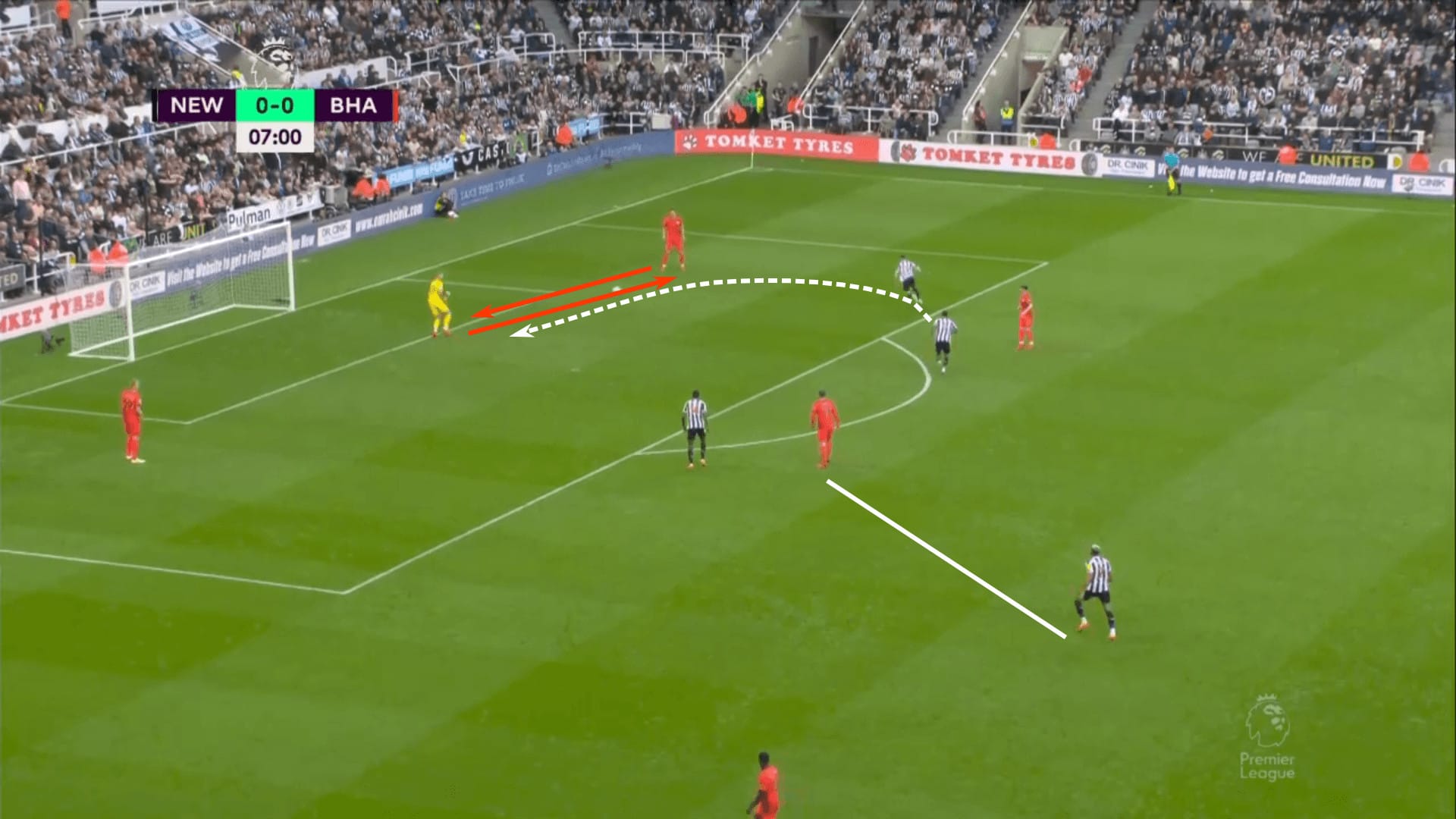
The next pass does go into the double-pivot and return to the left centre-back but notice that this is a trigger. Newcastle has still taken away the second player in the pivot, shadow-marking him at the top of the box, but now they’re in a position to sprint at the left centre-back as he looks to play higher up the pitch. Joelinton is also prepared to switch from the right pivot to the left. It’s a seamless switch among the first players in the press.
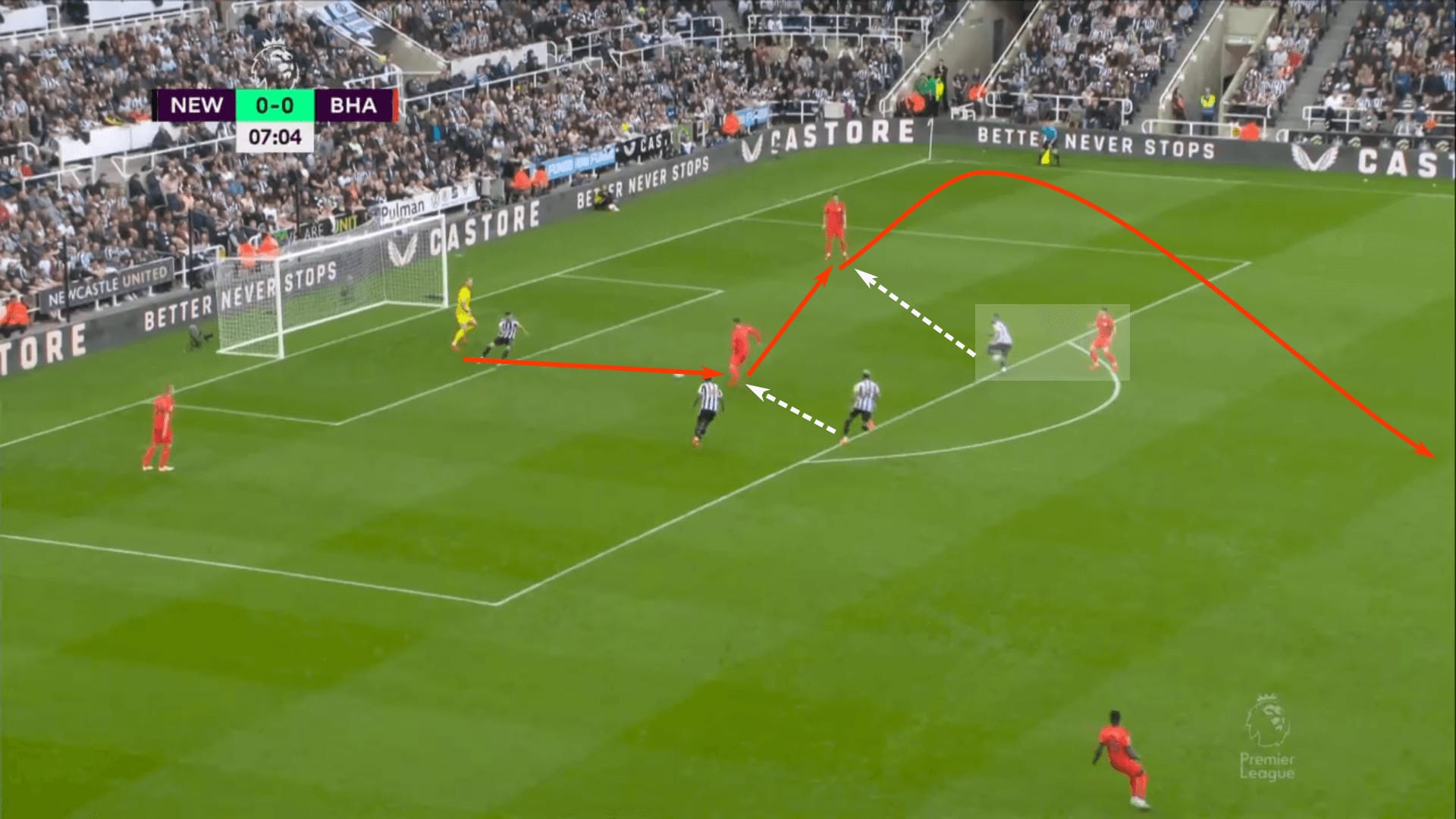
Depending on the opponent, Newcastle may even push to numeric equality near the opponent’s box. That does lead to a high-stakes man-for-man approach to their high press tactics.
Aston Villa was able to limit the success of Newcastle’s high press by taking a very De Zerbian approach in the build-out. The objective was to disconnect the forward in midfield lines from the defenders, creating a large gap between the lines. After starting high, the Aston Villa forwards would check between the lines to offer an outlet.
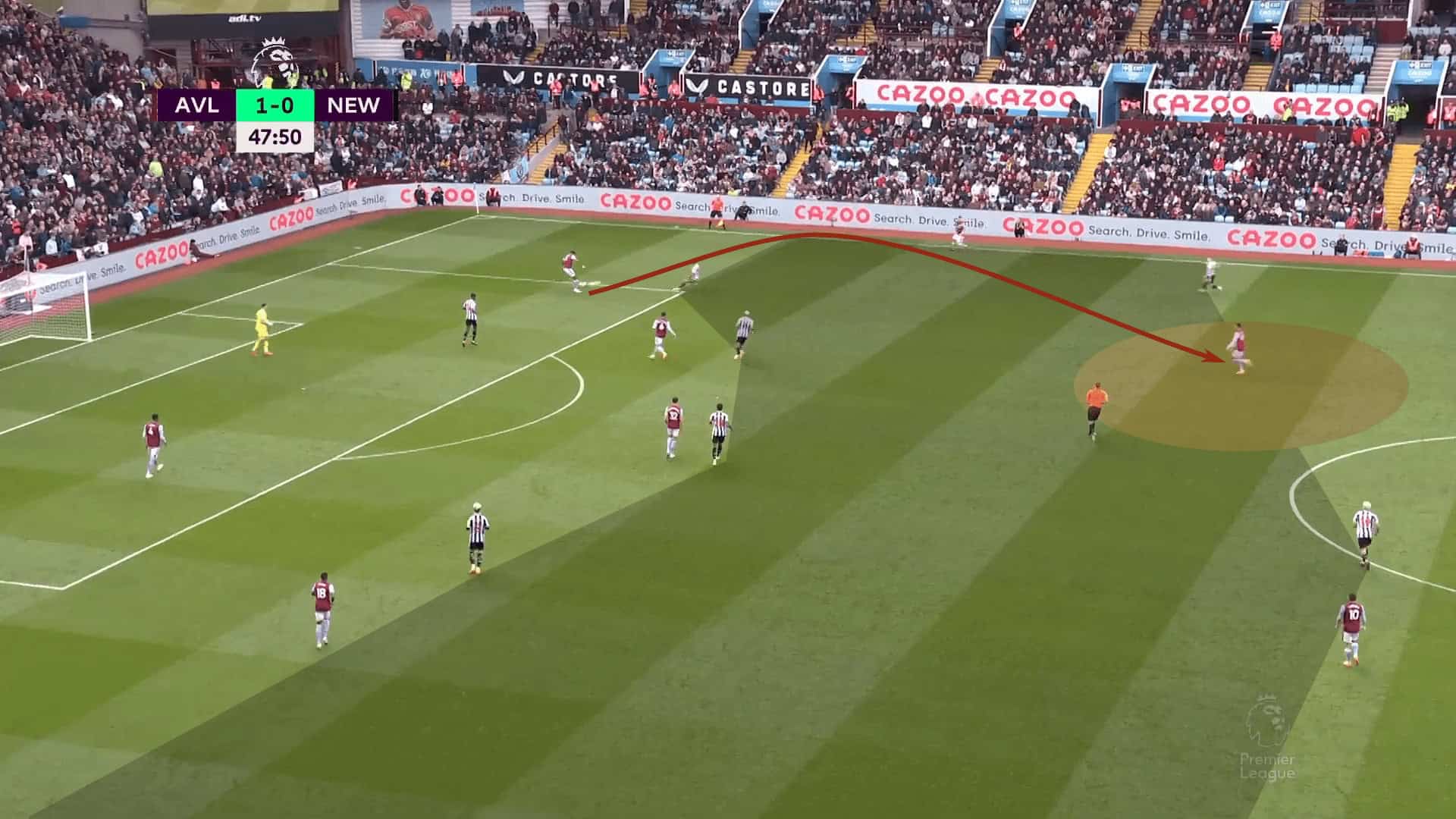
While this is a high-stakes engagement for Newcastle, they are a team that quickly recovers numbers behind the ball. The defenders effectively play a high line and delay opponents long enough for the midfield to recover their ground and rejoin the press.
When opponents push into Newcastle’s half of the pitch, they can again vary their shape to stifle the opponents’ preferred tactics, but it’s common to see them drop into a 5-4-1 with the two wingers dropping in line with the midfield.
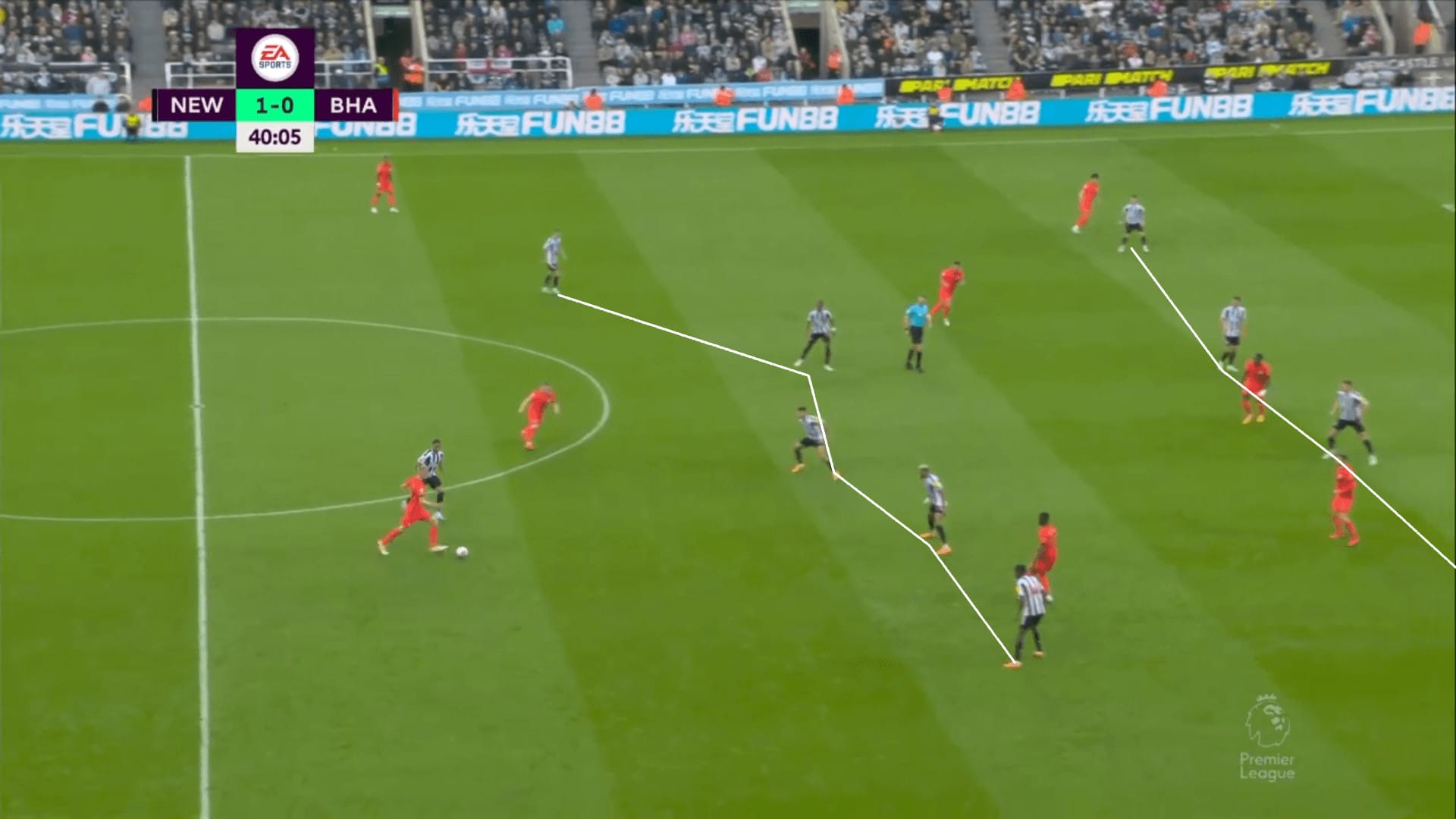
Howe’s side had an impressive goal-scoring record last season. Still, the tactical and personnel changes leading to a league-leading defensive record are arguably the most influential in Newcastle’s success. This is a team with a clever and knowledgeable approach to their defensive tactics. Their ability to adapt to opponents is second to none. It’s one of the reasons they should have continued success in the upcoming season.
Transitions phase
Newcastle are dangerous in transition.
The last section detailed their high press, so, naturally, it’s time to move to the moments the press creates: attacking transitions.
Howe’s game model gives every appearance of a German education. A robust high press created countless attacking transition opportunities in the opposition’s half of the pitch.
One of the principles of Newcastle’s counterattacks was that the first pass should go forward as often as possible. This is especially true when the recovering player was in a forward-facing position. Even if it was a matter of playing into a target whose only passing option was setting the ball back to his oncoming teammate, a positive first pass is a crucial principle.
That was key to their first goal in the rout of Tottenham. With the recovery coming in the middle third, the first pass was played forward, the second sent back into support coming from midfield, and the third played high into the wings to the feet of Joelinton.
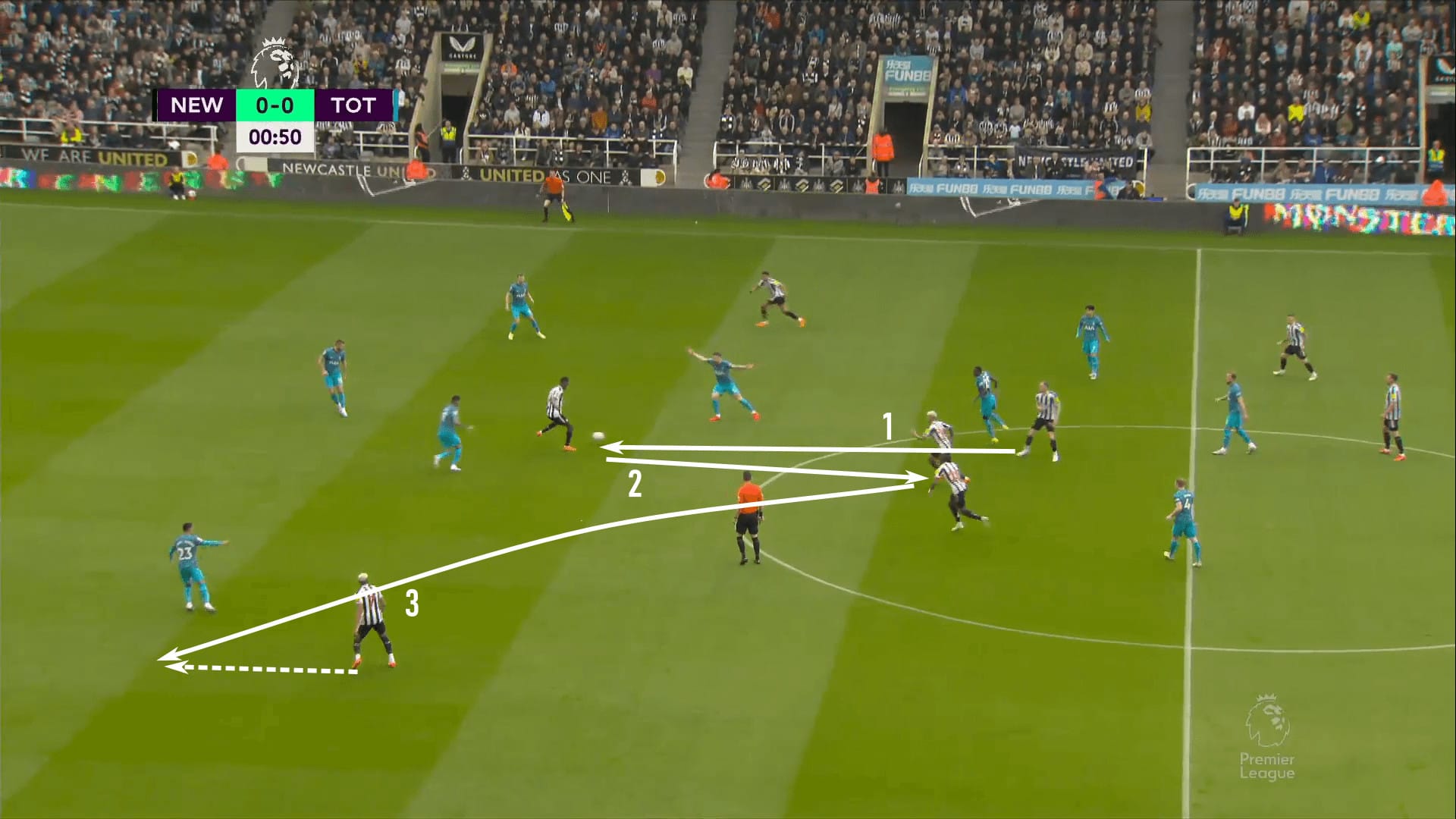
The winger was in a 1v1 scenario. He was given an overlapping run, allowing him to cut inside and take a shot for central position. Lloris made the save but pushed the rebound into the feet of Jacob Murphy for the opener just 60 seconds into play.
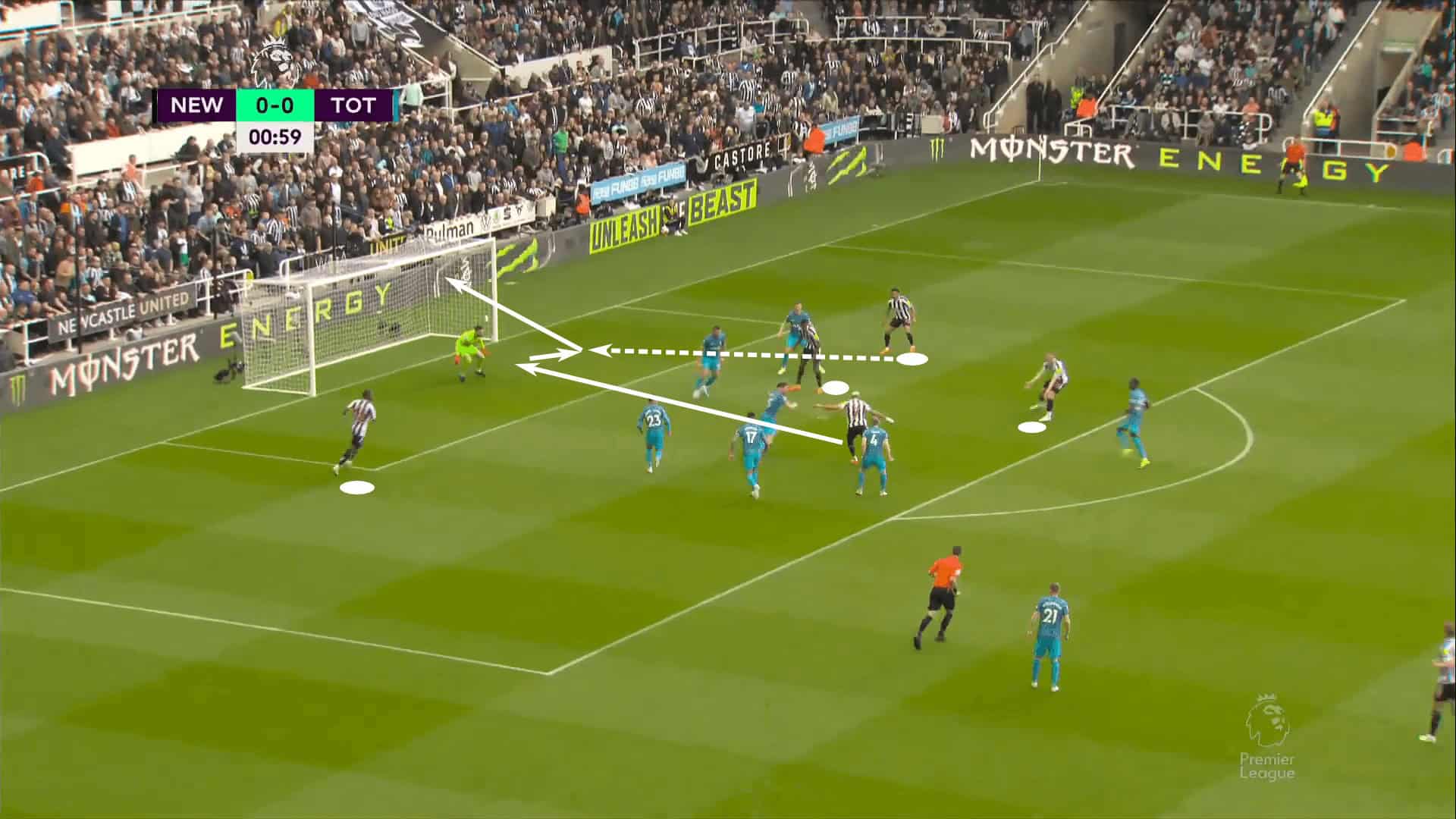
Murphy’s second goal against Tottenham also came in transition. Another well-executed Newcastle high press allowed them to win an entry pass to the feet of Son Heung-min. The ball was poked free to Murphy, with space to turn up the pitch.
One thing to notice is how compact Newcastle are in the high press. Eric Dier was in possession for Tottenham and had three options nearby. Newcastle had six players near the ball and cut out every short and intermediate option except the goalkeeper. Getting Dier to play in that shaded area was a win for the Newcastle press.
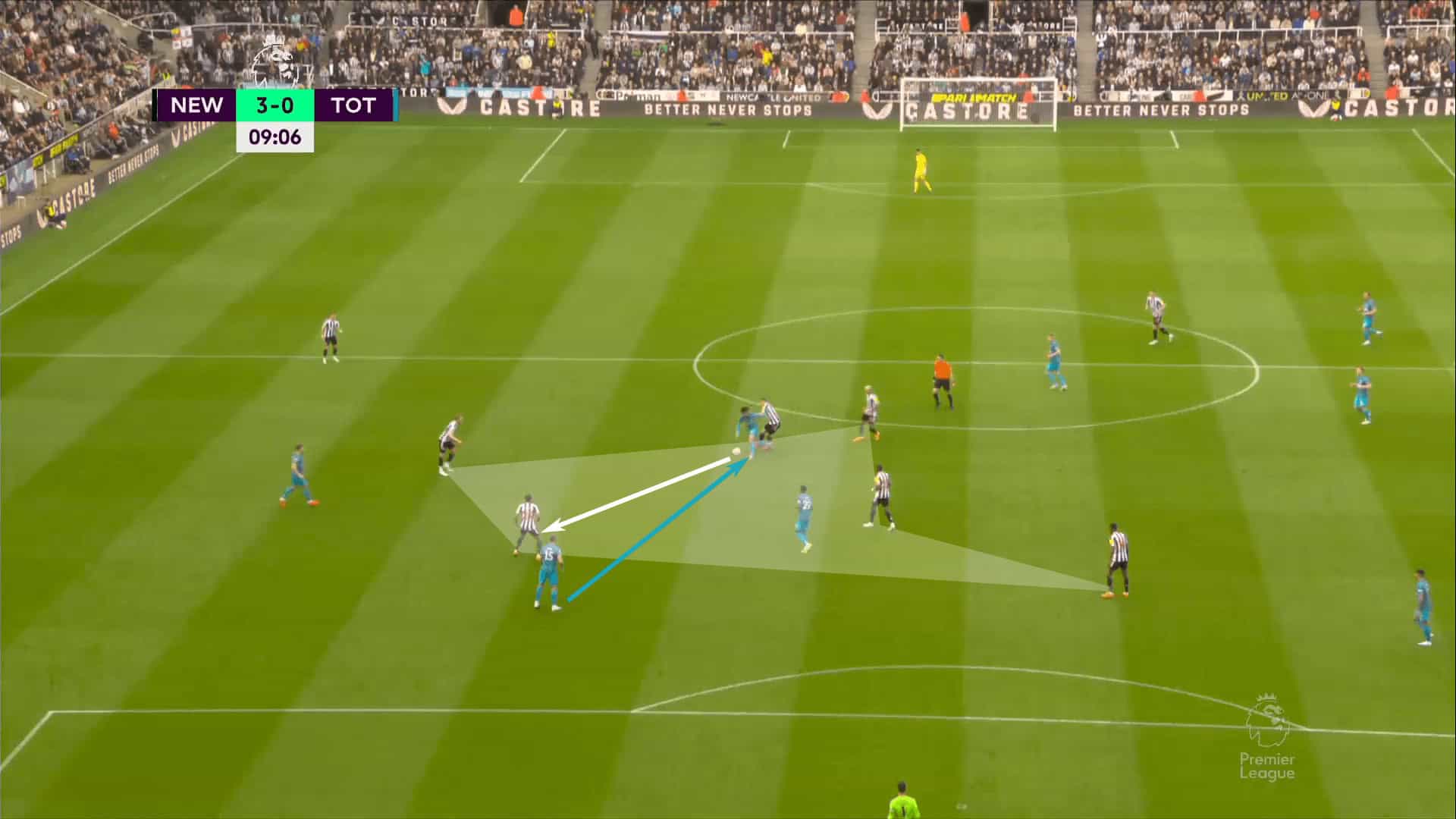
Back to Murphy’s action, Newcastle used their numbers near the ball to create chaos for the Tottenham defenders. With three players centrally and one to his right, Murphy was afforded space. The more significant concern for the Tottenham defenders were the players in front of Murphy, who were running into the box.
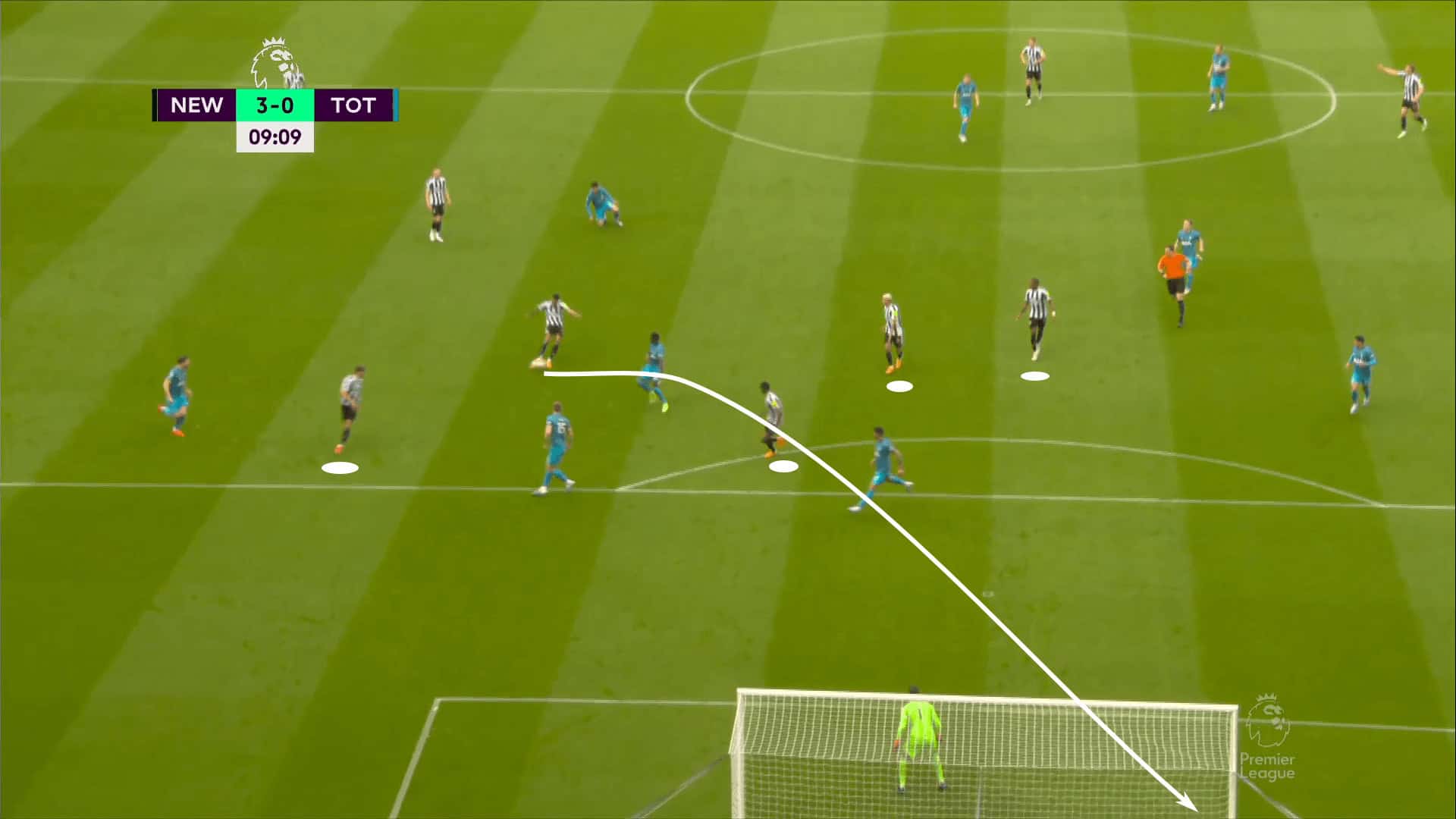
Murphy cracked a shot from approximately 30m out with that space, beating Lloris at the far post.
Newcastle’s counterattack is one of the best in the game. They can score through open possessions as well, but the attacking transitions are the most deadly. For opponents, a match versus Newcastle is a 90-minute challenge to avoid playing into their pressing traps.
We didn’t cover Newcastle’s defensive transitions but just know that this side recovers numbers behind the ball with an exceptional sense of dedication. Regarding their counterpressing, their PPDA of 9.78 indicates their effectiveness in defensive transitions.
Will Newcastle have the depth to compete in the EPL and Champions League?
In recent years, Manchester City, Liverpool and Chelsea have dominated English representation in the Champions League. That 4th spot has typically alternated between Manchester United and Tottenham. With Newcastle wrestling a top-four finish away from three of the Big Six, they’ll have their hands full competing in the two competitions and securing a second consecutive top-four finish.
Depth is critical to performing well on multiple stages. With the steady investment of the new owners, which includes net transfer dealings of approximately -€250m and more players likely to arrive before the window closes, Newcastle are quickly building out its depth to compete on multiple fronts. The biggest question is whether they’ll have enough to do so for the 2023/24 campaign.
They look like a club on the verge of consistent continental play, but with the big six constantly grappling for those coveted Champions League spots, Newcastle will find themselves pushed to the max this season. Time will tell if they can put together a good showing in both the EPL and Champions League.
Key player – Bruno Guimarães
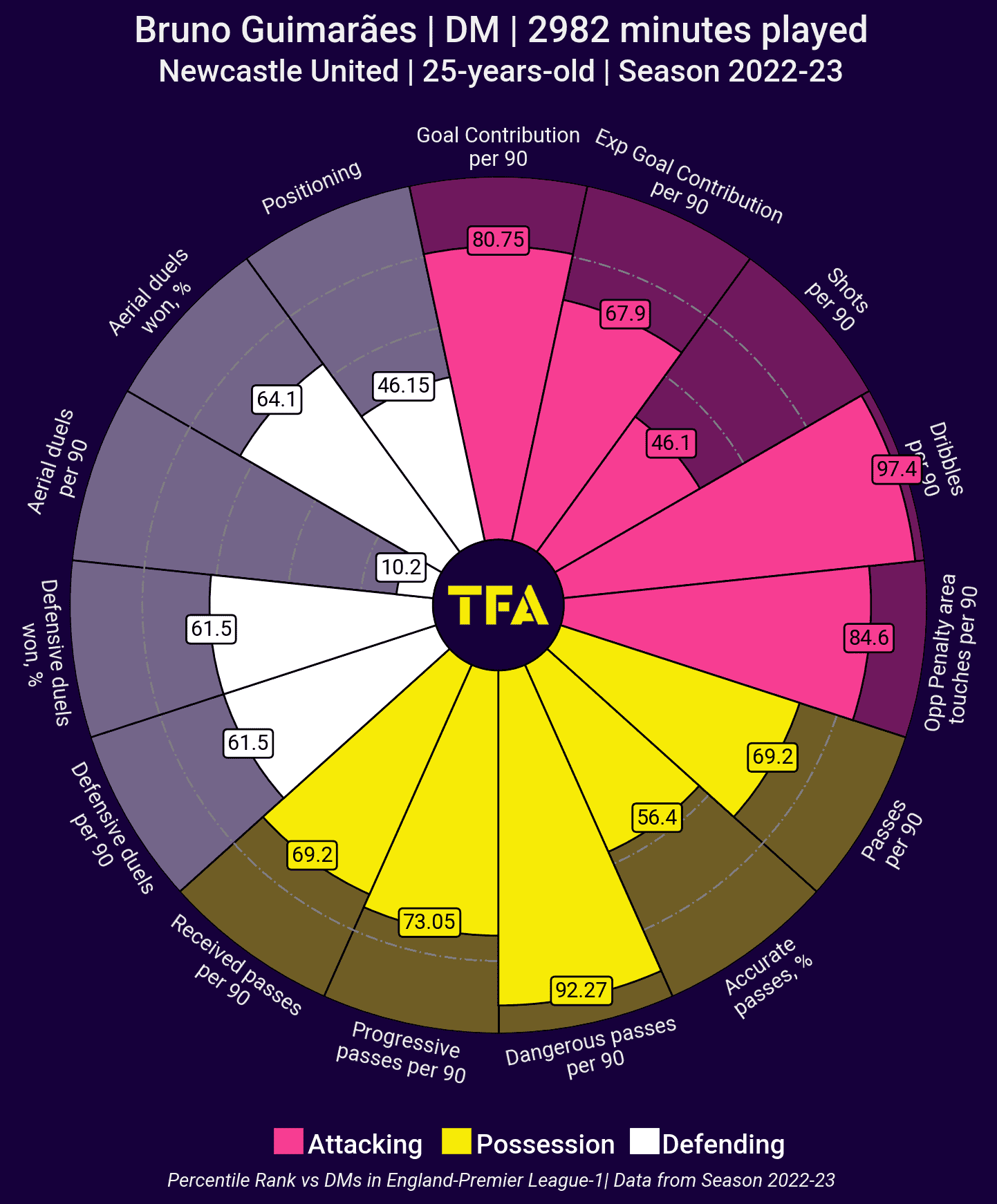
Tonali joins the squad and will feature next to the man who is arguably the most influential player in this Newcastle squad, Bruno Guimarães. The Brazilian was a standout last season, offering exceptional playing reliability both in and out of possession. He’s an extraordinarily complete player with the defensive know-how to be a force in Newcastle’s high press and the composure, technical quality and vision to hurt teams with his passing ability. He’s also one of the best dribblers in midfield in the world.
Playing next to Tonali changes his role in the upcoming season. Either player can operate from a deeper position, but either can also play a more box-to-box role. The preseason and early matches will give a sense of Howe’s thoughts on the two players’ positions, but, regardless, expect Guimarães to play a pivotal role in the midfield and potentially a the box-to-box midfielder.
One to watch – Alexander Isak
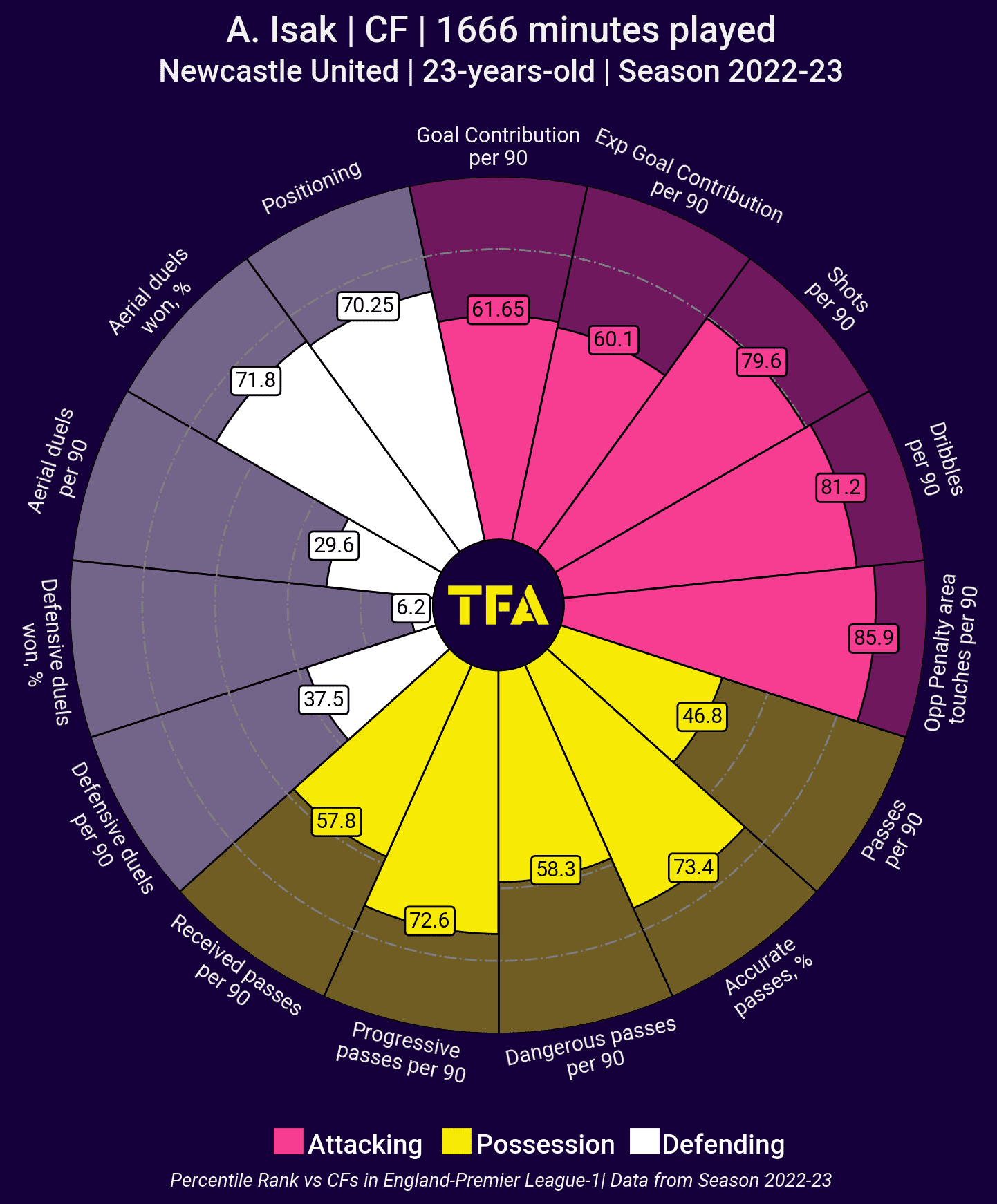
Alexander Isak had a good first season In the EPL. The Swede will look for a breakout campaign at St James’s Park in year two. The former Real Sociedad star has a high ceiling and has shown his adaptability to play multiple rules in the front line.
Last season, we really got a glimpse of his passing in playmaking ability. While not consistently operating as the #9, Isak influences the game by passing and dribbling. In both regards, he has shown flashes of brilliance.
Look for Isak to put it all together this year. If he can take his passing creativity and 1v1 dribbling threat they should last year and add it to the finishing that he showcased in La Liga; he’s a player who could have an exceptional season.
TFA Verdict: 5th
Eddie Howe’s team also have to contend with Champions League football this season, meaning extra strain on a squad that has enough quality to push for the top four but possibly not the depth to achieve it. Sandro Tonali is a class addition to midfield but they probably need to do more before the window shuts. 5th and a fun time in Europe should still be considered a good season in the North East.

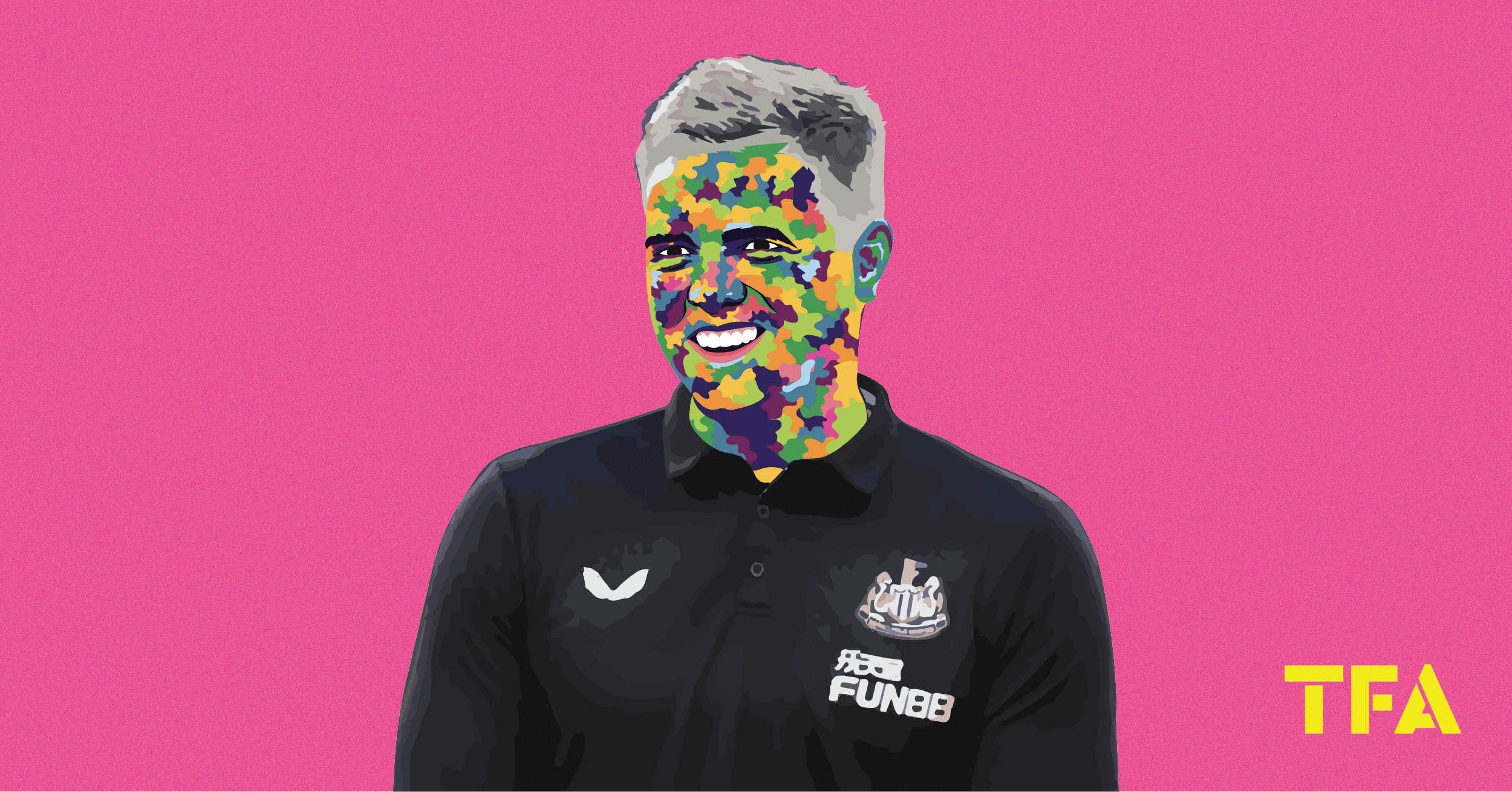



Comments